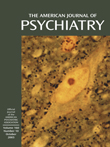Impairment of Olfactory Identification Ability in Individuals at Ultra-High Risk for Psychosis Who Later Develop Schizophrenia
Abstract
OBJECTIVE: Previous investigation has revealed stable olfactory identification deficits in neuroleptic-naive patients experiencing a first episode of psychosis, but it is unknown if these deficits predate illness onset. METHOD: The olfactory identification ability of 81 patients at ultra-high risk for psychosis was examined in relation to that of 31 healthy comparison subjects. Twenty-two of the ultra-high-risk patients (27.2%) later became psychotic, and 12 of these were diagnosed with a schizophrenia spectrum disorder. RESULTS: There was a significant impairment in olfactory identification ability in the ultra-high-risk group that later developed a schizophrenia spectrum disorder but not in any other group. CONCLUSIONS: These findings suggest that impairment of olfactory identification is a premorbid marker of transition to schizophrenia, but it is not predictive of psychotic illness more generally.



